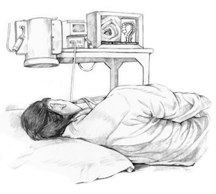This information does not constitute medical advice or replace discussion with your physician regarding you care or health concerns.
Colonoscopy is a procedure that uses a long, flexible, narrow tube with a light and tiny camera on one end, called a colonoscope or scope, to look inside the rectum and entire colon. Colonoscopy can show abnormalities of the lining (mucosa) of the large intestine. A gastroenterologist—a doctor who specializes in digestive diseases—performs this procedure.
Reasons why colonoscopy is performed include but are not limited to:
A gastroenterologist also performs a colonoscopy as a screening test for colon cancer. Screening is testing for diseases when people have no symptoms. Screening may find diseases or their precursors at an early stage, when a health care provider has a better chance of curing or preventing the disease.
The American College of Gastroenterology recommends screening for colon cancer:
Medicare and private insurance companies sometimes change whether and how often they pay for cancer screening tests. People should check with their insurance company to find out how often they can get a screening colonoscopy that their insurance will cover.
Read more about colon cancer at www.cancer.gov.
Preparation for a colonoscopy includes the following steps:
- aspirin or medications that contain aspirin
- nonsteroidal anti-inflammatory drugs such as ibuprofen or naproxen
- arthritis medications
- blood thinners
- diabetes medications
- vitamins that contain iron or iron supplements
People should call the gastroenterologist if there are additional questions about the preparation.
A gastroenterologist performs a colonoscopy at a hospital or an outpatient center. Conscious sedation is given help people to have study with minimal or no discomfort. The medical staff will monitor people’s vital signs and try to make people as comfortable as possible. A nurse or technician places an intravenous (IV) needle in a vein in the arm to give anesthesia.
For the test, the person will lie on a table while the gastroenterologist inserts a colonoscope into the anus and slowly guides it through the colon. The scope inflates the large intestine with air to give the gastroenterologist a better view. The camera sends a video image of the intestinal lining to a computer screen, allowing the gastroenterologist to carefully examine the intestinal tissues. The gastroenterologist may move the person several times so the scope can be adjusted for better viewing. Once the scope has reached the opening to the small intestine, the gastroenterologist slowly withdraws it and examines the lining of the large intestine again.
For the test, the person will lie on a table while the gastroenterologist inserts a colonoscope into the anus and slowly guides it through the rectum and into the colon.
The gastroenterologist can remove polyps during colonoscopy and send them to a lab for testing. Polyps are potential precursors of colon cancer, so removing polyps early is an effective way to prevent cancer.
The gastroenterologist may also perform a biopsy, a procedure that involves taking a small piece of intestinal lining for examination with a microscope. The person will not feel the biopsy. A pathologist—a doctor who specializes in diagnosing diseases—will examine all the tissue that has been removed irrespective of the removal technique. Biopsy results may take a couple of weeks.
Colonoscopy usually takes 30 to 60 minutes.
Some results from a colonoscopy are available immediately after the procedure. After the sedation has worn off, the gastroenterologist will share results with the person or a designee. Biopsy results can take a couple of days to come back and results will be mailed to the patient.
Bleeding and perforation are the most common complications from colonoscopy. Most cases of bleeding occur in people who have polyps removed. The gastroenterologist can treat bleeding that occurs during the colonoscopy right away. However, a person may have delayed bleeding up to 2 weeks after the test. The gastroenterologist diagnoses delayed bleeding with a repeat colonoscopy and treats it. Perforation may need to be treated with surgery.
People who have any of the following symptoms after a colonoscopy should seek immediate medical attention: